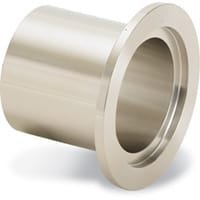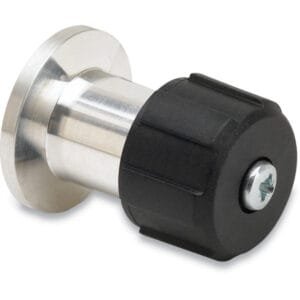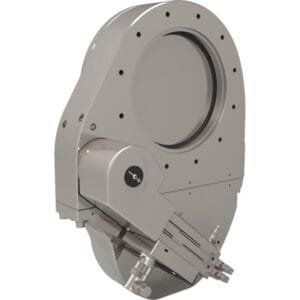KF (QF) HV 304L Stainless Steel Half Nipples (Inch Tube): Precision Fittings for Standard Vacuum Integration
KF (QF) HV 304L Stainless Steel Half Nipples (Inch Tube) are essential components in the assembly of high-vacuum (HV) systems that use inch-based tubing. These half nipples feature a single KF (QF) flange on one end, allowing for quick integration with standard vacuum hardware, while the open end accommodates direct connection to inch-dimensioned tubing through welding, brazing, or mechanical assembly.
Manufactured using high-quality 304L stainless steel, these fittings are designed to provide long-term corrosion resistance, mechanical strength, and low outgassing performance in high-vacuum environments. Their durability and compatibility with standard vacuum plumbing make them ideal for use in foreline lines, chamber extensions, or instrumentation ports—particularly in research labs, industrial vacuum processes, and OEM system platforms that adhere to inch-based standards.
Unlike full nipples, which are equipped with KF flanges at both ends for extended straight-line connections, KF (QF) HV 304L Stainless Steel Half Nipples (Inch Tube) are optimized for compact integration where only one KF flange is required. This makes them highly efficient for building modular vacuum sections or attaching custom tubing assemblies to larger systems.
Each half nipple is machined to tight tolerances and finished to a vacuum-compatible smooth internal surface. This attention to detail supports vacuum conditions down to 10⁻⁶ Torr or lower, depending on system cleanliness and assembly quality. The KF flange interface ensures easy, tool-free connection with centering rings and clamps, allowing users to assemble or reconfigure systems rapidly without specialized equipment.
TFM offers standard sizes for immediate use, but we also provide customization services for vacuum professionals who require non-standard tube lengths, diameters, or features such as precision weld preps or electropolished finishes. Our in-house engineering and fabrication capabilities allow us to deliver made-to-order solutions that meet the specific dimensional and material standards of your system.
In summary, KF (QF) HV 304L Stainless Steel Half Nipples (Inch Tube) are robust, vacuum-ready fittings tailored for inch-sized tubing systems. Their single-flange design, combined with proven 304L stainless steel performance, makes them a versatile and reliable choice for modern HV infrastructure.
Ordering Table
| Flange Size/OD | Type | Flange Material | Part Number |
| KF10 (1.18" OD) | Half Nipple, Clamp Style | 6061-T6 Aluminum | QF10-050-LFA |
| KF16 (1.18" OD) | Half Nipple, Clamp Style | 6061-T6 Aluminum | QF16-050-LFA |
| KF16 (1.18" OD) | Half Nipple, Clamp Style | 6061-T6 Aluminum | QF16-075-LFA |
| KF25 (1.57" OD) | Half Nipple, Clamp Style | 6061-T6 Aluminum | QF25-100-LFA |
| KF40 (2.16" OD) | Half Nipple, Clamp Style | 6061-T6 Aluminum | QF40-150-LFA |
| KF50 (2.95" OD) | Half Nipple, Clamp Style | 6061-T6 Aluminum | QF50-200-LFA |
Accessories Table
KF (QF) HV 304L Stainless Steel Half Nipples (Inch Tube) 2
| Description | For | Per Package | Part Number |
| Cast Clamps (Aluminum) | KF10, KF16 Flanges | 1 | QF16-075-C |
| Cast Clamps (Aluminum) | KF25 Flanges | 1 | QF25-100-C |
| Cast Clamps (Aluminum) | KF40 Flanges | 1 | QF40-150-C |
| Cast Clamps (Aluminum) | KF50 Flanges | 1 | QF50-200-C |
| Lever Clamps (Aluminum) | KF10, KF16 Flanges | 1 | QF16-075-CHA |
| Lever Clamps (Aluminum) | KF25 Flanges | 1 | QF25-100-CHA |
| Lever Clamps (Aluminum) | KF40 Flanges | 1 | QF40-150-CHA |
| Centering Ring (Aluminum with Fluorocarbon O-Ring) | KF10 Flanges | 1 | QF10-050-ARV |
| Centering Ring (Aluminum with Fluorocarbon O-Ring) | KF16 Flanges | 1 | QF16-075-ARV |
| Centering Ring (Aluminum with Fluorocarbon O-Ring) | KF25 Flanges | 1 | QF25-100-ARV |
| Centering Ring (Aluminum with Fluorocarbon O-Ring) | KF40 Flanges | 1 | QF40-150-ARV |
| Centering Ring (Aluminum with Fluorocarbon O-Ring) | KF50 Flanges | 1 | QF50-200-ARV |
| Description | For | Per Package | Part Number |





Reviews
There are no reviews yet.